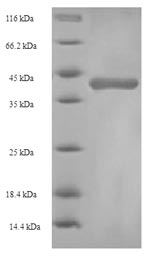This recombinant Rat Gsta1 protein is an E.coli-expressed protein (Full Length of Mature Protein). At the theoretical level, the steps needed for obtaining a recombinant protein are pretty straightforward. Obtain the Gsta1 gene, clone it in an expression vector, transform it into the host of choice, induce it, and then, the protein is ready for purification and characterization. In practice, however, dozens of things can go wrong. Poor growth of the host, inclusion body formation, protein inactivity, and even not obtaining any protein at all are some of the problems often found down the pipeline. So we choose the most suitable strain and vector for this recombinant Gsta1 protein expression and adopt the most optimized expression condition and purification method. Finally, mild condition and subsequent cumbersome protein-refolding procedures ensure this Gsta1 protein is soluble.
Gsta1 is a protein coding gene that encodes Glutathione S-transferase alpha-1. According to some studies, Gsta1 may have the following features.
The expression of GSTA1 was increased in PIA. The low levels of GSTA1 and GSTP1 in HGPIN and adenocarcinomas suggest a widespread lack of detoxification activity in these cells, which may be related to the oncogenicity of the prostate. Human GSTA1-1 reduces c-Jun N-terminal kinase signaling and apoptosis in Caco-2 cells. GSTA1 can be detected at low concentrations during the early stages of acute liver injury. GSTA1 is a more sensitive and accurate indicator than ALT. UGT1A1 and GSTA1 are regulated by soda through distinct signaling pathways, and differences in the regulatory mechanisms of UGT1A1 transcription.






